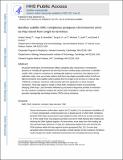Bacillus Subtilis SMC Complexes Juxtapose Chromosome Arms as They Travel from Origin to Terminus
Author(s)
Wang, Xindan; Brandão, Hugo B.; Rudner, David Z.; Le, Tung; Laub, Michael T
Downloadnihms867860.pdf (681.3Kb)
OPEN_ACCESS_POLICY
Open Access Policy
Creative Commons Attribution-Noncommercial-Share Alike
Terms of use
Metadata
Show full item recordAbstract
Structural maintenance of chromosomes (SMC) complexes play critical roles in chromosome dynamics in virtually all organisms, but how they function remains poorly understood. In the bacterium Bacillus subtilis, SMC-condensin complexes are topologically loaded at centromeric sites adjacent to the replication origin. Here we provide evidence that these ring-shaped assemblies tether the left and right chromosome arms together while traveling from the origin to the terminus (>2 megabases) at rates >50 kilobases per minute. Condensin movement scales linearly with time, providing evidence for an active transport mechanism. These data support a model in which SMC complexes function by processively enlarging DNA loops. Loop formation followed by processive enlargement provides a mechanism by which condensin complexes compact and resolve sister chromatids in mitosis and by which cohesin generates topologically associating domains during interphase. Keywords: SMC; ParB; condensin; cohesion; loop extrusion; TAD
Date issued
2017-02Department
Massachusetts Institute of Technology. Department of BiologyJournal
Science
Publisher
American Association for the Advancement of Science (AAAS)
Citation
Wang, Xindan, et al. “Bacillus Subtilis SMC Complexes Juxtapose Chromosome Arms as They Travel from Origin to Terminus.” Science, vol. 355, no. 6324, Feb. 2017, pp. 524–27.
Version: Author's final manuscript
ISSN
0036-8075
1095-9203